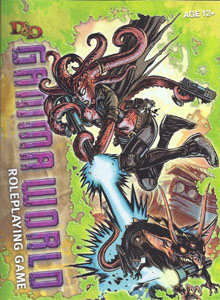 Something I didn’t delve into with my review of D&D Gamma World yesterday was the sample scenario that’s included in the back of the rulebook.
Something I didn’t delve into with my review of D&D Gamma World yesterday was the sample scenario that’s included in the back of the rulebook.
The brief advice given in the rulebook on creating adventures tells the GM to prep a railroad. The sample adventure, unsurprisingly, delivers just such a railroad. (It even goes out of its way to warn the GM not to create any significant diversions from “the main adventure”.)
This, of course, is fairly predictable. But beyond the railroad, this sample adventure — “Steading of the Iron King” — is one of the most bizarre scenarios I’ve ever read. It consists of seven combat encounters and virtually no connective tissue whatsover.
Let me unpack that statement a bit: We’ve certainly come to expect WotC’s modules to be completely dominated by combat encounters. But what makes this particular scenario remarkable is that it gives almost no indication of how the GM is supposed to transition the PCs from one combat encounter to the next.
The first three encounters are easy enough: Every day for the past month, a robot has come down out of the hills, fired a single rocket at the town’s wall, and then blown up. The PCs follow its trail up into the hills and find a tower full of bad guys. They attack the tower (Encounter S1), go through the door and fight some more bad guys (Encounter S2), and then go down a flight of stairs and fight some more bad guys (Encounter S3).
But this is where the adventure gets weird for me. Because they have now entered the “Steading Warrens”:
After the adventurers enter the steading and make their way to the installation of the Ancients beneath it, the encounters between poster maps are not physically connected. They pass through dozens of interconnected chambers, descend stone or metal stairs, and occasionally find straight connecting passages. These corridors, tunnels, and chambers aren’t shown on the battlemaps.
And that’s pretty much all you get.
As an experienced GM, of course, it’s fairly trivial to handle this sort of thing on-the-fly. A new GM, unfortunately, would probably be left floundering. (Which is unfortunate, because in many other ways the Gamma World boxed set would be an ideal introductory product.)
One can, of course, also comment on the eye-opening revelation that WotC thought an adventure consisting of one thin hook, seven combat encounters, and nothing else represents a good evening of gaming.
But the reason this scenario particularly caught my eye is that the almost complete absence of connective tissue actually calls a great deal of attention to the fact that we so rarely do pay attention to the way in which content is connected in an RPG scenario.
Consider, if you will, all the ways in which you could functionally connect these encounters.
It’s a big, underground complex, so we could very easily whip this up as a traditional dungeon crawl: Put the various encounters on a map, draw some corridors connecting them, and let the PCs explore room-by-room and intersection-by-intersection.
Option 2: We could use skill challenges to navigate the complex. You could either have a fresh skill challenge between each encounter, or maybe successful checks on an over-arching skill challenge would bring you to each encounter in turn.
As another option, the GM could simply narrate the transitions (making a point of describing the dankness of certain tunnels, the strange humming heard elsewhere, and so forth).
How else could you structure and/or connect a sequence of encounters?
By this I mean, what’s the actual interaction — mechanical or otherwise — which happens at the table which moves you from one combat encounter to the next.
And this is, of course, the simpler version of this question. Remove the assumption that you’re moving from combat encounter to combat encounter, and suddenly we’d also have to take into consideration how each “chunk” of content is structured… and how are we deciding what an appropriate “chunk” is?
This is an area that I don’t feel gamers actually give much conscious thought to: We’ve learned a few forms subliminally and by chance, but because it’s largely an invisible bias we rarely consider whether there might be a better way of structuring scenarios.












“One can, of course, also comment on the eye-opening revelation that WotC thought an adventure consisting of one thin hook, seven combat encounters, and nothing else represents a good evening of gaming.”
Or three evenings’ gaming, more like. >:)